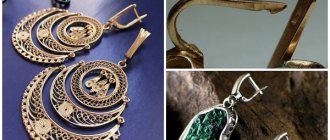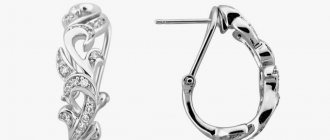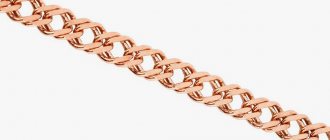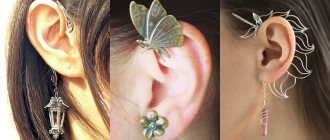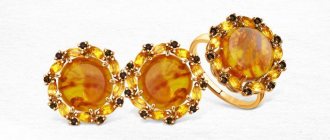Carbine
Carabiner lock
This is the most popular mechanism in the jewelry world. It is a loop, one side of which has a moving bracket. Opening such a lock on a bracelet is quite simple. It is enough to press the spring-loaded valve .
This design prevents the connecting ring from falling out
Experts recommend being careful with the retainer. Sharp jerks can easily deform the loop. In some cases, if you are not careful, you can break the clasp .
Shringelny
This mechanism is a hollow ring containing a spring lock. Such fasteners are mass-produced exclusively in large factories. That is why it is often found on costume jewelry.
Spring clasp
The mechanism is lightweight, durable and small in size. Often a spring lock is used for thin chain bracelets .
The only drawback of such a lock is that the spring weakens or breaks over time. Most often this occurs as a result of regular wear. Due to everyday stress, the fasteners cannot withstand and break.
Box-shaped
Craftsmen like to use such a fastener for products where, according to the plan, the fastener should not stand out from the overall composition
Box locks look like two elements: a clasp is inserted into a square piece, which has small protrusions at the tip.
The box mechanism is not often used in the jewelry industry. The fact is that the process of making the retainer is quite labor-intensive . But, despite this, the lock always looks beautiful on the accessory , as it fully corresponds to the intended design.
Types of locks for beads and bracelets
LOCKS FOR BRACELETS AND BEADS When choosing a bracelet or beads, first of all we evaluate its beauty. But there is an important detail that you need to pay special attention to. This is a locking mechanism that secures the connection of the jewelry. Fasteners must meet several requirements. As a functional element, the lock must be reliable, holding firmly in the closed position. As a decorative element, it should be harmoniously combined with the product itself and not cause discomfort when worn - do not scratch, do not cling to clothes, and can be easily opened by hand.
Types of locks on chains and bracelets
Modern types of clasps on bracelets and chains are presented in options that allow you to find a compromise between reliability and beautiful design.
One of the simple and reliable mechanisms is the spring ring clasp. This is a widespread variety and is a round lock with a spring latch. It is usually made by machine and is often used in large-scale production jewelry.
Light weight, strength and small size make this bracelet lock popular for both chain bracelets and neck chains. The disadvantages include the fact that the spring that returns the valve to its original position may fail. If you don't notice it in time, the decoration can be lost. Due to its miniature size, the lock latches cause some difficulties in operation.
The carabiner lock on a chain is the most popular
Another common type of lock for bracelets is a carbine (hook buckle clasp, lobster claw). This mechanism looks like a hinge with a spring-loaded bracket. The connecting ring that fits inside the carabiner cannot disengage due to the spring latch. This is a strong and reliable lock that can withstand greater weight of the product compared to a spring lock. Many people also find that a carabiner is easier to use than a spring rifle, which is not easy to open with one hand.
It is assembled by hand, so the quality depends on the professionalism of the jeweler. The advantages of a carabiner lock on chains include reliability and repairability. During repairs, you can disassemble and replace a damaged or worn spring.
If the bracelet has been subjected to sudden jerks while being worn, the carabiner should be carefully inspected: the resulting gap between the moving part and the loop may allow the connecting ring to pass through.
Box lock on chain - for bracelets and necklaces
The box clasp type on bracelets is somewhat less common than those described above. Perhaps due to the complexity of its production. Most often, a box lock is used in those bracelets where, according to the designer’s plan, the clasp should not stand out from the overall design. Also, the “box” lock is often placed in necklaces. A box lock can withstand a fairly massive decoration.
Box lock pattern: regular, and with locking loops for security
All types of box locks are based on the use of two halves - a box with a hole and a latch, which is a bar folded in half with notches at the end. The latch is inserted into the box and thanks to the notches it is held inside. The structure is strengthened with one or two fixing loops. They increase reliability, but they themselves can cause the bracelet to get caught on clothing.
The shape of the lock box can be modified. For example, in an oval box with windows in the side faces, a horizontal latch is fixed. The double-sided horizontal latch is even more secure.
Hinge locks for bracelets
A hinge by definition is “a movable connection between two parts that provides them with rotational motion around an axis.” It is this principle of “locking” that is quite often used for bracelets (and rarely for chains).
A hinge lock is used to connect bracelets consisting of links (glider) or solid (rigid) bracelets. An integral element of the hinge joint of the lock is a pin - a metal “nail” that is inserted inside the hinge and secures the joint.
Folding bracelet lock (buckle lock)
Sometimes a special type of folding lock is highlighted, which is quite often used for link (glider) bracelets, including watches. This lock is designed on a hinge (due to which it bends in half) and has a latch. It is considered convenient, but not the most reliable - the latch is quite easy to open if the bracelet accidentally hits something uneven.
Screw lock bracelet or necklace
Bracelets made of beads, as well as necklaces (chokers), for example pearl ones, are quite often “closed” with a screw (threaded) lock. The lock looks very aesthetically pleasing from a jewelry point of view, is easy to use and is loved by many. However, it is still not very reliable and can spin up in the most unexpected places.
Crutch clasp (toggle, toggle)
A popular clasp for chain bracelets is the so-called toggler clasp, which is sometimes called a T-lock, or crutch. The lock consists of a large round link and a T-shaped pin, which is inserted into the circle and locked in it due to the tension force. This is one of the easiest locks to make, dating back to ancient times. That is why they like to put it on ethnic-style jewelry. Despite its primitiveness, the crutch clasp is quite reliable - for cases when you are not wearing jewelry that is too large for you.
Crochet lock for bracelets and neck chains
And finally, the hook lock - consisting of a hook and loop - is recognized as even simpler and more ancient. It is held in place by the same tension force. And it holds up well! Moreover, its design is such that the hook will not just jump out of the loop - you need to apply some force to this.
https://juvelirum.ru/
A spring lock consists of a fixed body, a movable bolt (latch), a spring and an end eye. It is usually manufactured by machine and used in large-scale production products. If the soldered ring of the spring lock becomes unbent as a result of the chain jerking, then this problem can be easily eliminated. If the spring fails or the movable bolt of the lock is bent, the lock will most likely have to be replaced. The advantages of springels include their very low weight. A spring lock consists of a fixed body, a movable bolt (bolt), a spring and an end eye.
Without lock
Accessories without locks are a hit in the jewelry world. This product is very easy to put on and take off . But the main advantage of not having a lock is reliability. The owner of a stylish one-piece piece of jewelry can be sure that she will not lose it due to a broken clasp.
So, the lock is the key detail on the bracelet. It depends on him how the jewelry will be fixed on the hand. Therefore, when choosing a product, you should carefully examine the lock and test it in action.
28.10.20
Beaded bracelet clasp. Master Class
A homemade beaded bracelet is an original decoration that is pleasant not only to wear, but also to weave. The most interesting aspects of its manufacture, of course, are the choice of materials, as well as the weaving process itself. But at the same time, the clasp is perhaps the most important element of the product.
There are, of course, bracelets without beaded clasps. But their disadvantage is that they can easily tear when put on. Only two or three types of this fittings are widely used, but in fact their choice is quite large. We will find out what to choose and how to fasten the clasp on a beaded bracelet so that the product lasts as long as possible.
Choosing a clasp
Now you can easily choose suitable accessories from the assortment available in stores:
- round;
- screw;
- spring;
- carbine;
- magnetic, as well as many others.
When choosing accessories, you should proceed from the type of product.
In this article we will look at the most commonly used options, and also give advice on how to make your own original clasp for a bracelet woven from beads.
Screw lock for bracelet
This type of fittings is very popular due to its versatility - it is equally suitable for both small and complex multi-layered decorations. It is aesthetically pleasing and does not weigh down the product.
In addition, the screw lock is quite easy to secure. There are several ways to do this. The simplest of them involves creating a beaded ring. You need to string several beads onto a thread or fishing line, and then half a lock.
Then you should pick up the beads again and close the ring.
The screw lock has the disadvantage that it is not the most reliable. There is a risk that the lock will come loose at the most inopportune moment, and the bracelet will slip off your hands unnoticed.
Bracelet with carabiner
Another popular type. It is also versatile, but due to its rough appearance it will look better on simple items.
The carabiner can withstand a lot of weight, it is convenient to use, since it can be fastened with one hand. One of the advantages is that a broken carabiner can most often be easily repaired.
Sometimes, while wearing the lock, a gap forms between the loop and the moving part, from which the ring pops out.
Decorative lock for bracelet
Toggle, or toggle, also performs a decorative function in addition to its main function. It consists of a large ring and a crossbar that is inserted into it. This is a very primitive, but nevertheless reliable mechanism. It attaches in the same way as a screw lock. Or you can simply attach it with a coil of wire or a miniature metal ring.
It is advisable to use it on jewelry that fits properly. For wide bracelets, you can use multiple toggles.
Magnetic clasp
Magnetic clasps are very convenient to use, however they are usually quite heavy, making them unsuitable for some types of bracelets. One of the advantages is that this fittings are easy to hide and are not noticeable. Magnets are often used for decorations made using the knitted rope technique.
This is an ideal clasp for a wide beaded bracelet, as well as those products in which the beads are located vertically.
It is multi-row, it is secured with additional horizontal beads, the fishing line is passed through the holes of the fittings. For greater reliability, the number of additional beads and turns of fishing line is increased.
Thanks to this lock, the beaded fabric will not twist at the point of attachment to the fittings.
If you wish, you can experiment and create a clasp yourself.
This can be a large bead with a loop or a beaded toggle. This braided lock looks neat and harmonious. It will match any decoration.
Below is a simple example. We will need:
- beads of suitable colors (sizes used – 11/0, 8/0);
- beading needle;
- fishing line or monofilament.
Beaded clasp patterns
Quite often it is difficult to choose suitable fittings from those available in stores. Don’t worry, a homemade clasp will suit your product perfectly. To weave it, always choose beads of the same type as for the product itself.
Let's briefly look at the main schemes:
- Beaded bracelet clasp with button. Well suited for products made using the American rope technique. At the end of weaving the product, it is necessary to put on a bead, again beads, a button, then beads again. Then you need to go back through the bead and continue the tourniquet. Make a loop of a suitable diameter from the opposite end of the bracelet.
- The second way to make a button fastener is applicable for mosaic canvas. It is necessary to make a ring using the mosaic weaving technique. We alternate 15/0, 11/0 cylindrical beads. The second row is made with cylindrical beads 11/0, the third - with round beads of the same diameter. We make the last row 15/0, you need to dial three pieces. The number of beads needed depends on the desired loop size.
- We start toggle by forming a loop-ring using the mosaic technique. Then we fold it in half and sew it together. The result is a fairly dense ring, attached to the main part of the product with a chain. On the opposite side we weave a rectangle, also with a mosaic. We also sew it along the edges so that a hollow tube is formed. We perform a brick stitch - a row of 15/0. We put on a bead, three beads 15/0. We go back through the bead and go through the weave beads, securing it. This part must also be attached to the chain in order for the lock to close.
Step-by-step weaving instructions
We offer a simple scheme that any needlewoman can handle. The basis for this lock will be an elongated button. The operating time will be only 20 minutes. Despite its simplicity, this homemade fittings are very reliable and look neat. Moreover, it itself performs a decorative function and will decorate your work.
Step 1: making an elongated button
We begin to form our button. We string 4 small beads onto the fishing line, then the same number of 8/0, and then again 4 pieces of 11/0. Then we add one more bead of suitable size between the beads. In total, this row should have 4 pieces 10/0 and 2 - 8/0.
Step 2: attach the button to the bracelet
If all the steps in the previous step were performed correctly, you will get an element of the original lock, which will need to be secured at one end. All that remains is to complete the second part of the lock and secure it at the other end.
We weave with bricks until a web of 4 beads is formed at the edge. Fold the resulting piece in half and sew it together. To do this, you need to use beads of the first and last rows protruding beyond the edges of the fabric.
Step 3: form the second part of the fastener
Finally, let's move on to the second part. It consists of the following steps:
- We turn the product over and begin to form a lock. In this case, as an example, we used a decoration with glass beads, from which a thread comes out; it is on this thread that we will begin to string the beads. We string 18 beads, after which we return to the glass beads.
- We form the next row with brick weaving, moving through one bead. Thus, we get 1 bead between the beads of the row.
- Let's move on to the second row. We use size 8/0 for it. Then, just as we did when creating the first row, we insert a bead between the beads of the row.
- We begin the third and last row. Between 8/10 of the previous row we insert 2 small beads. We bring this to the end of the row and finish the work. We form a knot from the fishing line and cut off the excess. We securely hide her tail in the product so that it does not come apart.
Our recommendations
- Before attaching the clasp to your beaded bracelet, consider which hand will be more comfortable to fasten or unfasten it. It should be attached on the same side.
- If you have chosen fittings that match the design, but very much doubt its reliability, fasten it through a double twist ring so that the lock can be easily changed later.
- When choosing beads, give preference to a Japanese or Czech manufacturer. Maybe you will be able to make the canvas itself from Chinese material, but definitely not the lock.
If you are a beginner and have not yet worked with fittings and they scare you, you can make a bracelet without a clasp. But if you carefully follow the step-by-step lessons, you can easily make any beadwork and cope with attaching the lock.
SOURCES:ttp://juvelirum.ru/vidy-juvelirnyh-izdelij/braslety/zastyozhki-dlya-brasletov-kakie-zamochki-luchshe/ttp://www.rubysbeadwork.com/ToggleClasp.html
ttp://biserok.org/zastezhki-iz-bisera/
Source: https://masterbisera.com/braslety/zastezhka-dlja-brasleta-iz-bisera/
